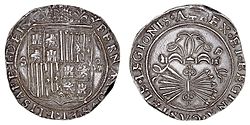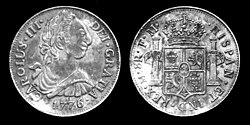TREASURE !!! A Rare Spanish New World Silver 8 Reales COB, MEXICO, PHILIP IV with Chop Marks
TREASURE !!!
A very nice example, Spanish New World Silver 8 Reales COB.
Rare with the natural hole/bubble/void in the planchet overlooked by the mint.
Mint; oM, Mexico City
Date; nv., c. 1634-1665
Reign; PHILIP IV (1621-1665)
ASSAYER; nv., most likely "P" (1634-1665)
Grade- I
The coin has a dark patina from being buried.
Weight; 26.6 grams.
Note; This coin is among a sub-group of cobs that were made with "natural" holes, bubbles or voids overlooked by the mint. The coin has several "Chinese Chop Marks" and test cuts. The test cuts were made to make sure the coin was solid silver. Believe it or not, there was counterfeiting going on in antiquity. The chop marks were proof that the coin was tested by the Oriental province assayer and stamped (which was a stamp of approval) to all in the region the coin is genuine and then could be exchanged for goods and services. The coin was recovered from a shipwreck or excavated from the ground or a river. Unfortunately the provenance is unknown.
TTI-547221
Additional Notes: These coins were the most desirable currency of the world for over 300 years from the 1500's - 19th century and were legal tender in the United States until the Act of 1857.
Long tied to the lore of piracy, "pieces of eight" were manufactured in the Spanish Americas and transported in bulk back to Spain, making them a very tempting target for seagoing pirates. In the Far East, it also arrived in the form of the Philippine peso in the Philippines as part of the Spanish East Indies of the Spanish colonial empire through the Manila galleons that transported Mexican silver peso to Manila in the Manila-Acapulco Galleon Trade, where it would be exchanged for Philippine and Chinese goods, since silver was the only foreign commodity China would accept. In Oriental trade, Spanish dollars were often stamped with Chinese characters known as "chop marks" which indicated that particular coin had been assayed by a well-known merchant and determined to be genuine. The specifications of the Spanish dollar became a standard for trade in the Far East, with later Western powers issuing trade dollars, and colonial currencies such as the Hong Kong dollar, to the same specifications.
The first Chinese yuan coins had the same specification as a Spanish dollar, leading to a continuing equivalence in some respects between the names "yuan" and "dollar" in the Chinese language. Other currencies also derived from the dollar include the Japanese yen, Korean won, Philippine peso, Malaysian ringgit, French Indochinese piastre, and etc since it was widely traded across the Far East in the East Indies and the East Asia.
Contemporary names used for Spanish dollars in Qing Dynasty China include benyang (本洋), shuangzhu (双柱), zhuyang (柱洋), foyang (佛洋), fotou (佛頭), foyin (佛銀), and fotouyin (佛頭銀). The "fo" element in those Chinese names referred to the King of Spain in those coins, as his face resembled that of images of the Buddha; and the "zhu" part of those names referred to the two pillars in the Spanish coat of arms.
Spanish dollar
|
||||||
|
||||||
|
||||||
|
||||||
|
||||||
|
||||||
The Spanish dollar, also known as the piece of eight (in Spanish: Real de a ocho, Dólar, Peso duro, Peso fuerte or Peso), is a silver coin of approximately 38 mm (1.5 in) diameter worth eight Spanish reales. It was minted in the Spanish Empire following a monetary reform in 1497. It was widely used as the first international currency because of its uniformity in standard and milling characteristics. Some countries countersigned the Spanish dollar so it could be used as their local currency.[1]
The Spanish dollar was the coin upon which the original United States dollar was based, and it remained legal tender in the United States until the Coinage Act of 1857. Because it was widely used in Europe, the Americas, and the Far East, it became the first world currency by the late 18th century.[2][3][4] Aside from the U.S. dollar, several other currencies, such as the Canadian dollar, the Japanese yen, the Chinese yuan, the Philippine peso, and several currencies in the rest of the Americas, were initially based on the Spanish dollar and other 8-real coins.[5] Diverse theories link the origin of the "$" symbol to the columns and stripes that appear on one side of the Spanish dollar.[6]
The term peso was used in Spanish to refer to this denomination, and it became the basis for many of the currencies in the former Spanish colonies, including the Argentine, Bolivian, Chilean, Colombian, Costa Rican, Cuban, Dominican, Ecuadorian, Guatemalan, Honduran, Mexican, Nicaraguan, Paraguayan, Philippine, Puerto Rican, Peruvian, Salvadoran, Uruguayan, and Venezuelan pesos. Of these, "peso" remains the name of the official currency in Argentina, Chile, Colombia, Cuba, Dominican Republic, Mexico, Philippines, and Uruguay.
Millions of Spanish dollars were minted over the course of several centuries. They were among the most widely circulating coins of the colonial period in the Americas, and were still in use in North America and in South-East.
















